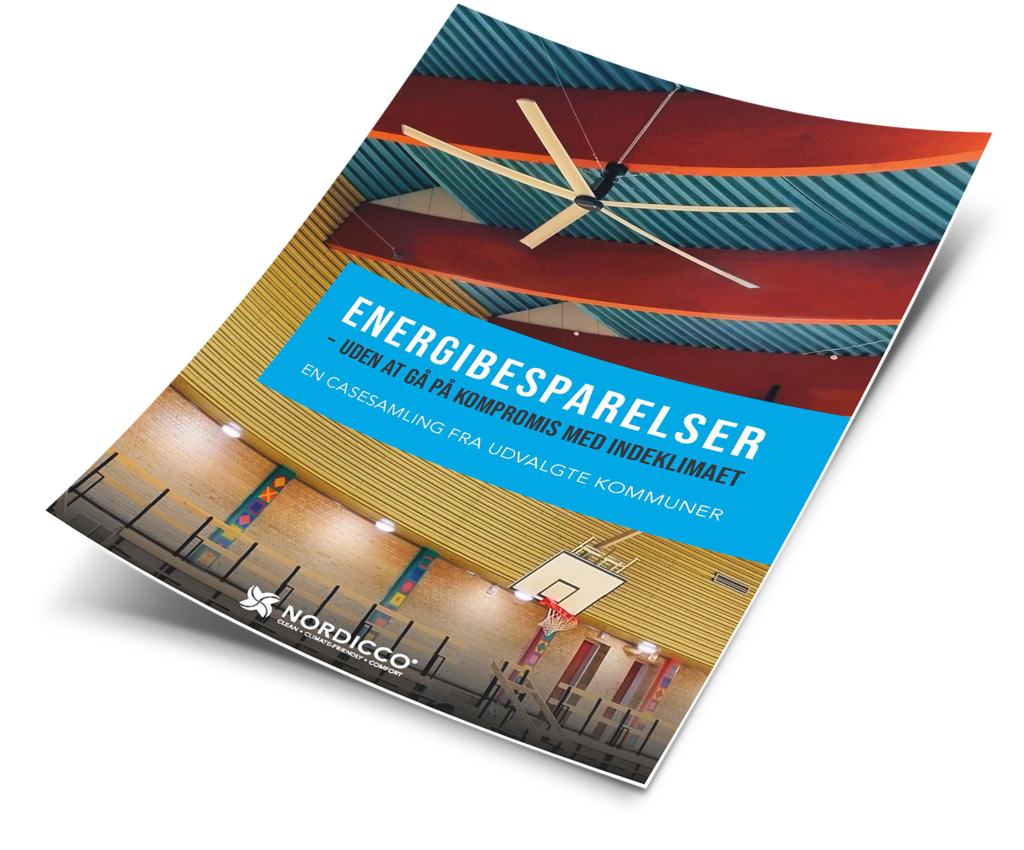According to test report by the Danish Technological Institute Northern Light is the most efficient system for disinfection and distribution of large air volumes while occupants are present in the room. See examples of different applications here. Our fans come in various sizes and colors, see the table for more info:
| Fan size | Coverage area | Applications | Weight |
|---|---|---|---|
| 2 meters | 250 m2 | Offices | 33 kg |
| 3 meters | 600 m2 | Foyers | 39 kg |
| 4 meters | 800 m2 | Warehousing | 45 kg |
| 5 meters | 1000 m2 | Sports facilities | 51 kg |
Northern Light® is the most efficient system for disinfection and distribution of clean air*. The product line of patented HVLS fans comes with integrated UVC light in the air blades.
The fan silently circulates massive amounts of air across the UVC lamps integrated on the upper side of the air blades. This effectively combats COVID and other airborne diseases (nature.com), as the pathogens are continuously exposed to UVC light.
Advantages
From € 5.795,- excl. VAT/GST
Call us at +45 73 70 90 83 or fill out the form below to get a completely non-binding quotation.
Despite their significant air flow output, the Northern Light HVLS fans operate quietly due to the advanced motor technology and air blade design that helps minimize noise. This makes them suitable for environments where noise control is essential.
Below are air flow efficiency and noise level graphs for the 3, 4, and 5 meter systems. The first graphs show air volume at different speed settings (RPM). And the noise level graphs show decibel (dB) readings at different speeds (RPM).
The Northern Light Pro productline is tested accoring to the leading industry standard for air circulation; AMCA 230-15. The CFEI (ceiling fan energy index) is 4.89 at 40% speed and 1.01 at 100% speed for the 5-meter fan. The CFEI data is based on 208/60/3 testing per ANSI/AMCA Standard 230 and 10 CFR 430.
Download the Technical Specifications for the Northern Light product line here.
Download Revit files for Northern Light Disinfection Fans:
README_Revit_Nordicco
Revit-files-NorthernLight_LOD200_AllSizes
Revit-files-NorthernLight_LOD300_3m
Revit-files-NorthernLight_LOD300_4m
Revit-files-NorthernLight_LOD300_5m
Here you can access CAD files for Northern Light disinfection fans.
We provide 2D and 3D versions of the filetype .dwg which can be found in this zip folder:
We also have SVG files available for Northern Light systems. See links below. If you are in need of other files for a project please contact us and we will help in providing them to you directly.
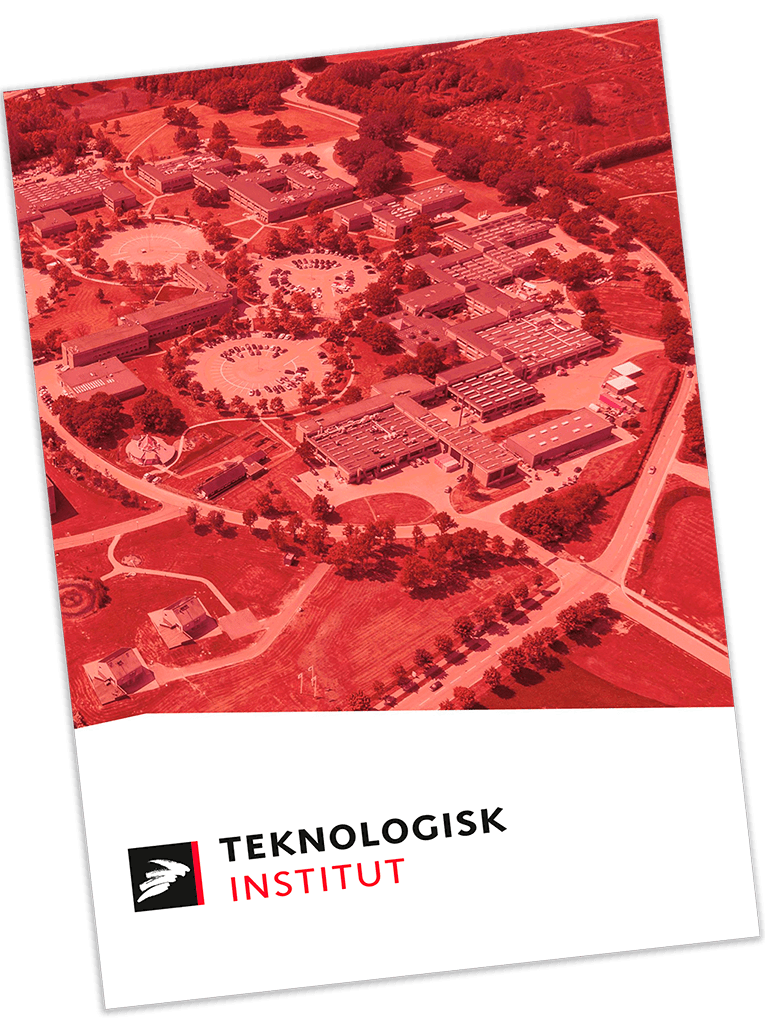
The Danish Technological Institute has carried out a large-scale test of Northern Light® and the integrated UVC light to analyze the system’s ability to disinfect air and inactivate viruses. The test was performed with live virus in microdroplet form in a closed test chamber.
The results show a significant reduction in the virus concentration in the room when the germicidal UVC light is turned on. Specifically, the virus concentration is down to only 5% of the starting concentration after just 15 minutes. The Northern Light® system is therefore referred to as the most efficient system for disinfection and distribution of large volumes of air, while people are present in a room, as far as the authors are concerned.
For more than 70 years, UVC-light has been used as an effective way to disinfect air and deactivate airborne pathogens such as viruses and bacteria. Northern Light® is the industry’s most efficient system for disinfecting and distribution of clean air (source: Danish Technological Institute).
So by using Northern Light® companies and public institutions can optimize their indoor climate by continuously removing the threat from airborne viruses such as Influenza and the Corona virus causing COVID. (Nature.com)
“The most common way COVID-19 is transmitted from one person to another is through tiny airborne particles of the virus hanging in indoor air for minutes or hours after an infected person has been there.”
explains Dr. Alondra Nelson, head of the White House Office of Science and Technology Policy and Deputy Assistant to the President (The White House).
The patent pending Northern Light® UVC fan silently circulates massive amounts of air across the UVC lamps elegantly integrated on the upper side of the air blades, effectively deactivating airborne pathogens as they’re continuously exposed to the UVC light. Northern Light® creates outdoor like conditions indoors, and by that a safer, cleaner and more comfortable environment for employees, visitors and customers alike.
It’s a well-established fact that UVC light in combination with HVLS ceiling fans is an effective way to eliminate airborne pathogens and provide a clean and safe environment. That UVC light is able to deactivate +99% of airborne pathogens is also a well-established fact, confirmed by leading institutions and universities around the world.
The patented Northern Light® HVLS fans come with 5 powerful UVC disinfecting lamps elegantly integrated on the upper side of the air blades. Specifically they are situated at the periphery of the air blades, to maximize air exposure.
As the air moves over and across the air blades, the UVC light ensures an effective disinfection, eliminating airborne pathogens such as bacteria and viruses. Furthermore, the uplight design makes it possible to have the Northern Light® HVLS fans safely operating while people are present in the room.
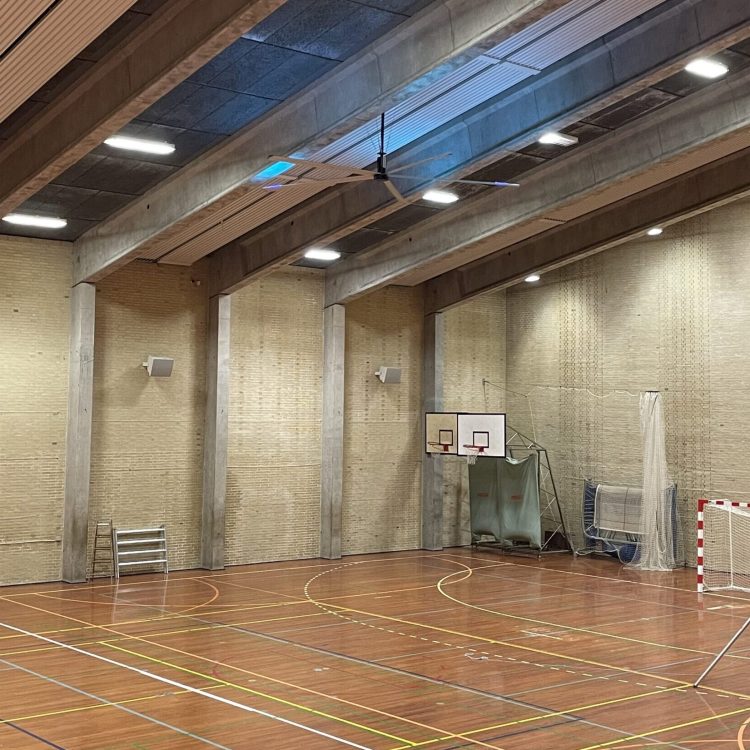
Experts from the company UltraAqua UV have performed multi-physical COMSOL simulations and gathered all findings and background in the report: Technical Background HVLS UV-C SYSTEM, Northern Light.
Read excerpts from the report here or click the link below to download the full report including appendices.
There is an obvious possibility in applying UC-C technology for cleaning of SARS-CoV-2 and other bio contaminated air during a pandemic. Evidence shows that the Corona virus is airborne and that poorly ventilated buildings have higher risks of infectious disease transmission between people. Estimations suggest that inhaling about 1000 vira is enough for the Corona virus to take hold. Thus, it is clear that increasing air changes per hour with germ free air lowers the risk of inhaling sufficient Corona viruses to get infected.
Viruses are small making them more susceptible to UV-C than other organisms, leading to WHO to recommend UV-C radiation for inactivation of such organisms. One approach to minimize the risk of getting infected is regular opening of windows for ventilation, but such a strategy creates variating and unpredictable airflows and areas with little ventilation. Upper-air UV-C systems are well known for disinfection in hospital rooms and the effect highly increase with fans distributing the germ free air. High Volume Low Speed (HVLS) fans combined with UV-C delivers high rate of germ- free air in a low airspeed downwards manner, diluting virus numbers and lowers the infection risk.
Compared to general Upper-UV-C systems without fans improvement of 77 percent has been reported when adding the fans. The product combining a HVLS fan with UV-C integrated in the wings are patent-pending by Nordicco A/S and has been named Northern Light. Northern Light is showing an efficiency of 87,9% per air passage over the wings against SARS- CoV-2 by Comsol CFD analysis. No other known technology has paralleled efficiency for such high amounts of air evenly distributed in each recirculation passage.
The global health-threatening crisis from the COVID-19 pandemic, caused by the severe acute respiratory syndrome coronavirus (SARS-CoV-2), highlights the scientific and engineering potentials of applying ultraviolet (UV-C) disinfection technologies for bio contaminated air as the major technology for removal of SARS-CoV-2 transmission. Various environmental public settings worldwide, from hospitals and health care facilities to shopping malls, airports and schools, are considering implementation of UV disinfection devices for disinfection of circulating air streams. (Milad, 2020)
Evidence shows that the virus is airborne in tiny droplets travelling for several hours. (Thorseth, A 2020. DTU.) (Ashrae, 2020). Authorities now generally recommend regular passive ventilation (opening windows) of indoor spaces to minimize impact of airborne viruses. New evidence of airborne spread cases is a daily event.
In facilities where there are infectious patients, evidence shows that poorly ventilated buildings have higher risks of infectious disease transmission. (Li et al,2007) demonstrated the association between ventilation and air movements in buildings, and the transmission/spread of infectious diseases.
Coughing by a COVID-19 infected individual can produce about 3000 droplets in a wide size range (10−1 to 102 μm). Droplets larger than 100 μm deposit rapidly on surfaces. (Wang, J., 2020) (Garcia et al., 2020). Tiny droplets (0.1−5 μm) are capable of dissolving with the aerosol, remaining airborne, and traveling hundreds of meters. (Garcia et al., 2020) (Morawska, L., et al., 2020) Intermediate size range (5−100 μm) droplets also shrink to tiny sizes due to evaporation, (Garcia et al., 2020) and the peak concentration of droplets in bioaerosols are in two diameter ranges: 0.25−1.0μm and 2.5−10 μm. (Liu, Y,. et al., 2020)
The majority of larger emitted droplets are drawn by gravity to land on surfaces within about 1–2 m from the source (see Figure 2). General dilution ventilation and pressure differentials do not significantly influence short-range transmission. Conversely, dissemination of smaller infectious aerosols, including droplet nuclei resulting from desiccation, can be affected by airflow patterns in a space in general and airflow patterns surrounding the source in particular. Of special interest are small aerosols (<10 μm), which can stay airborne and infectious for extended periods (several minutes, hours, or days) and thus can travel longer distances and infect secondary hosts who had no contact with the primary host. (Ashrae, 2020) (Stadnytskyi,v. et al., 2020)
Disinfection using UV radiation has been a fast growing chemical-free technology over the past decades. UV radiation is highly efficient at controlling microbial growth in any medium, such as water and air, as well as on any type of surface. (Milad, 2020) (Thorseth, A 2020. DTU.)
UV-C radiation has a short wavelength and high energy, compared to other UV radiation, which enables
it to function the best in a direct line and at a short distance. Due to the high energy of the UV-C radiation, it is bound to the inverse square law where the propagation of light intensity decreases exponentially with
increasing distance from the light source. Studies developed by (Escombe et al., 2009) and (Casanova et al., 2010) provided that there is a sufficient circulation inside the room to mix the air, upper-room UV fixtures have shown to be an effective asset for use in infection control.
UV-C systems inactivates microorganisms by damaging the structure of nucleic acids and proteins at the molecular level, making them incapable of reproducing. The most important of these is DNA, which is responsible for cell replication (Harm 1980). Absorbed UV photons can damage DNA in a variety of ways, but the most significant damage event is the creation of pyrimidine dimers, where two adjacent thymine or cytosine bases bond with each other, instead of across the double helix as usual (Diffey 1991). In general, the DNA molecule with pyrimidine dimers is unable to function properly, resulting in the organism’s inability to replicate or even its death (Diffey 1991; Miller et al. 1999; Setlow 1997; Setlow and Setlow 1962). An organism that cannot reproduce is no longer capable of causing disease.
Based on systematic literature reviews the World Health Organization (WHO) recommended use of bacteria disinfecting UV-C radiation in upper room use as a means of prevention and control of tuberculosis infection (WHO, 2019). (Ko et al., 2000; Peccia et al., 2001). Escombe et al. (2009) studied bactericidal UV radiation in the upper part of rooms in a hospital in Lima without air-conditioning, and found a marked reduction in the risk of transmission of airborne tuberculosis despite the high relative humidity of 77%. (Thorseth, A 2020. DTU.)
Centers for Disease Control and Prevention (CDC) has approved UV as an adjunct to filtration for reduction of tuberculosis risk and has published a guideline on its application (CDC 2005, 2009). (Evidence Level A).
Personalized ventilation systems that provide local exhaust source control and/or supply 100% outdoor, highly filtered, or UV-disinfected air directly to the occupant’s breathing zone (Cermak et al. 2006; Bolashikov et al., 2009; Pantelic et al. 2009, 2015; Licina et al. 2015a,2015b) offer protection against exposure to contaminated air.
Ultraviolet radiation has been explored to reduce the spread of airborne infections at least since the 1930s. Ultraviolet radiation can disinfect surfaces, room air (called upper air systems), and air in ducts. To inactivate an organism (such as a virus), the ultraviolet radiation must strike the organism. Upper air (room) systems rely on air circulation in the room to carry microorganisms to the upper air zone where sufficient ultraviolet light shine on them. (Mphaphlele, 2015; Escombe et al., 2009; DHHS, 2009)
UV-C irradiation is highly effective in inactivating and inhibiting SARS CoV-2 replication (Bianco, et al., 2020)
At a virus density comparable to that observed in SARS-CoV-2 infection, an UV-C dose of just 3.7 mJ/cm2 was sufficient to achieve a 3-log inactivation, and complete inhibition of all viral concentrations was observed with 16.9 mJ/cm2. UV-C effect on viruses has been intensely studied by several authors (As an example; Rauth, A.M., 1965)
These results are important for the development of novel sterilizing methods to contain SARS- CoV-2 infection.
The primary objective of upper-air UV-C placement and use is to interrupt the transmission of airborne infectious pathogens within the indoor environment.
In a room ventilated by an HVLS overhead fan, the air layers are well mixed so the supplied disinfected fresh air can reach the occupant level.
In naturally or HVAC (Heating, Ventilation and Air Conditioning) ventilated spaces, fresh air is uneven distributed throughout the space, so localized areas may have stagnant pockets, resulting in poor air quality and buildup of pollutants including bacteria and virus. Fans disperse these pockets and increase the circulation of fresh disinfected air, evenly distributing it throughout the space, diluting virus number per volume and improving indoor air quality. (C.Canada, 2020)
The use of UV technologies in the HVAC industry is well established and understood. The technology has been paired with HVAC equipment use since the early 1940s and the benefits they provide reduce occupant exposure to contagions by disinfecting indoor air near specially designed UV devices. (C.Canada, 2020)
Increasing of the rate of air circulation between the upper and lower air zones, can improve the performance of upper-room ultraviolet germicidal irradiation (UVGI) systems by up to 77 per cent (C.Canada, 2020).
Conclusion
It has been shown by simulation that an 87.9% inactivation of SARS-CoV-2 can be achieved with the Northern Light fan per passage of recirculating ventilation air. The degree of inactivation has been calculated from the modelled dose distribution using a UV sensitivity reported in the literature (k-value of 1.87 cm2/mJ (Bianco et al., 2020)). The effect is expected to effectively reduce likelihood of inhaling the around 1000 SARS-CoV-2 that leads to Covid19 disease in treated areas.
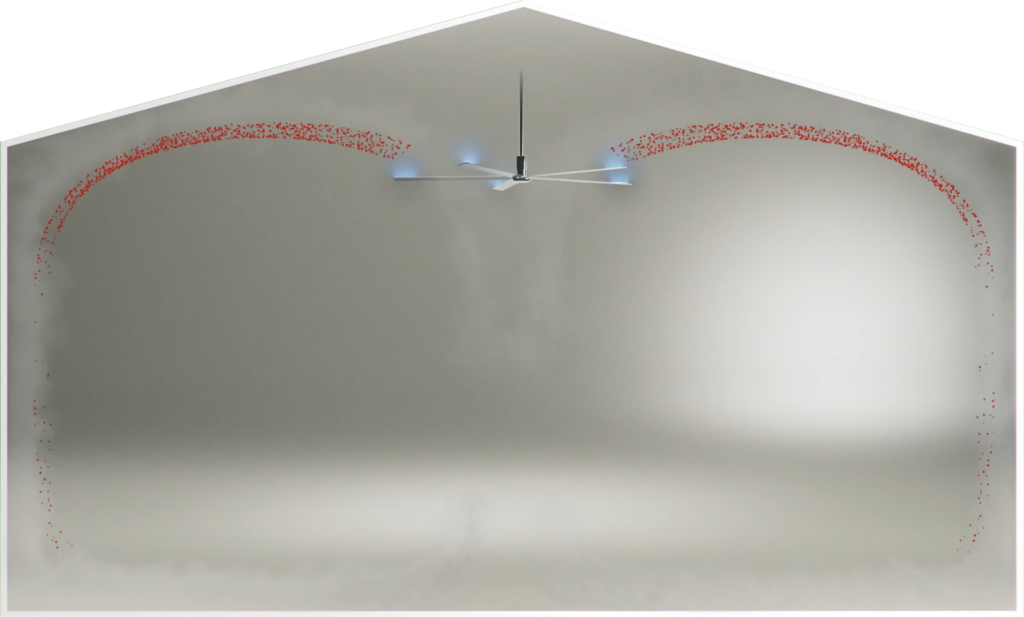
Northern Light® has been tested by the Danish Technological Institute and the conclusion of the test is unequivocal: Nordicco’s Northern Light® is the industry’s most efficient system for continuously disinfecting and distribution of clean air.
If you are interested in learning more about our solutions, or perhaps you have a project you’re dimensioning, please feel free to get in touch with us at +45 73 70 90 83 or on info@nordicco.eu.
The Mini is a small white ceiling fan with remote control. The perfect option for class-rooms and offices.
Northern Air® Pro is our line of large HVLS fans from 2-5 meters. Often used to deliver substantial energy savings.
Aggressive Environment HVLS fans are developed for challenging environments such as aquatic centers.
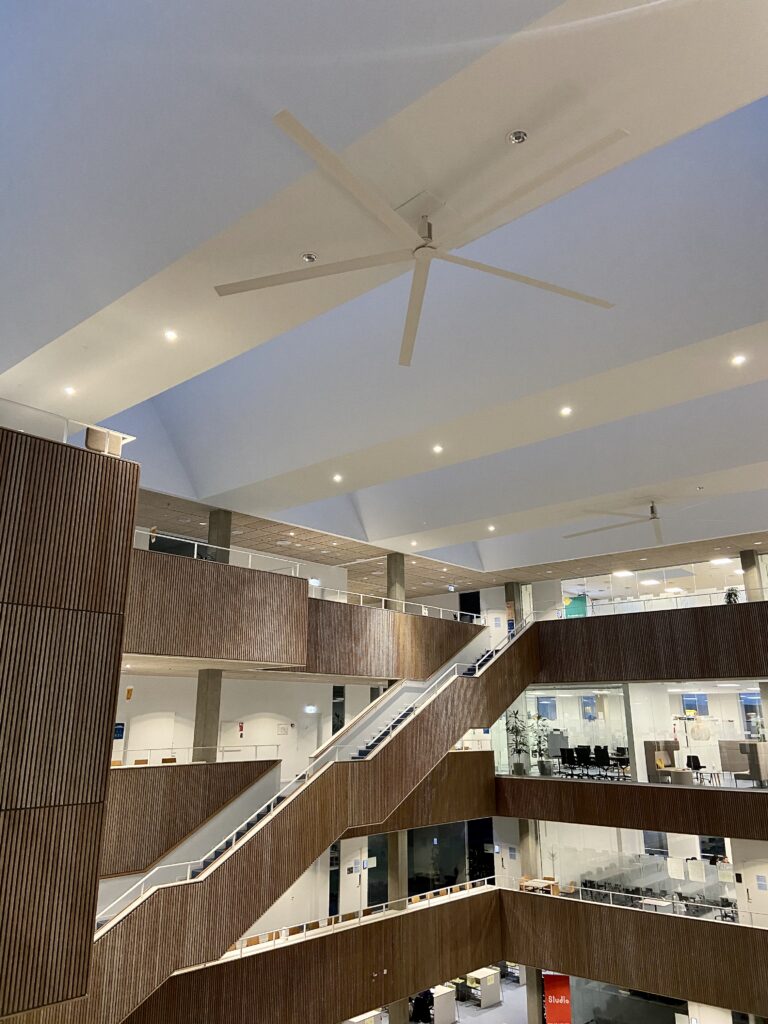

NORDICCO® HVLS fans are designed and manufactured in Denmark and continuosly adjusted to European needs and expectations regarding performance, energy efficiency and design.
